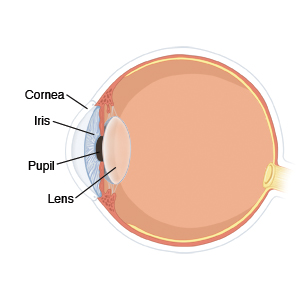A flash burn or welder’s burn occurs when a person is exposed to too much ultraviolet light. This often occurs if someone is welding without the correct eye protection. It may also occur after getting too much sunlight in high-glare places like the beach or in snow.
The injury is to the cornea, which is the clear part in the front of the eye, and the conjunctiva, which is the clear tissue covering the white part of the eye and inside eyelids. This sensitive area is very painful when injured, but it often heals quickly. The pain often goes away in 1 to 2 days.
You may be given eye drops to enlarge (dilate) the pupil if you are in pain. Eye drops may also help to prevent an infection. The dilating drops may continue to work for hours or days, causing blurry vision.
Home care
-
A cold pack may be applied over the eye, with the eye closed, for 20 minutes at a time. This helps to reduce pain. To make a cold pack, put ice cubes in a plastic bag that seals at the top. Wrap the bag in a clean, thin towel or cloth. Never put ice or a cold pack directly on the skin.
-
Wear sunglasses if you are sensitive to the light.
-
You may use acetaminophen or ibuprofen to control pain, unless another medicine was prescribed. (Note: If you have chronic liver or kidney disease or ever had a stomach ulcer or digestive tract bleeding, talk with your healthcare provider before using these medicines.)
If an eye patch was applied:
-
You may place the cold pack over the eye patch.
-
If you were given a follow-up appointment for patch removal and a reexamination, don’t miss it. An eye patch should not be left in place for more than 48 hours, unless advised by your healthcare provider.
-
Don’t drive a motor vehicle or use machinery with the patch in place. You will have trouble judging distances with only one eye.
-
If an eye drop or ointment was prescribed, use it as directed.
-
Don’t wear contact lenses until your eyes have healed and all symptoms are gone.
Prevention
Take these safety steps to prevent this injury in the future:
-
Wear a welder's mask when welding.
-
Wear totally dark glasses when using a tanning bed.
-
Wear sunglasses with UV-A and UV-B protection for the beach and snow.
Follow-up care
Follow up with your healthcare provider, or as advised. If your eye was patched, follow the advice given for patch removal.
If you were asked to remove an eye patch yourself, see your provider if you still have pain after removing it.
When to get medical advice
Call your healthcare provider right away if any of these occur:
-
Increase in eye pain, or pain that doesn't get better after 48 hours
-
Discharge from the eye
-
Eye redness or swollen eyelids
-
Vision gets worse


